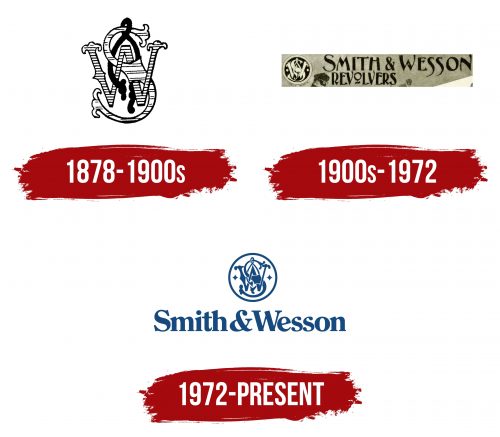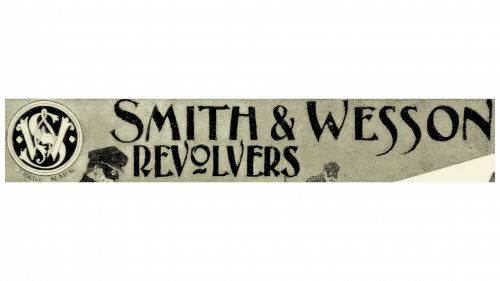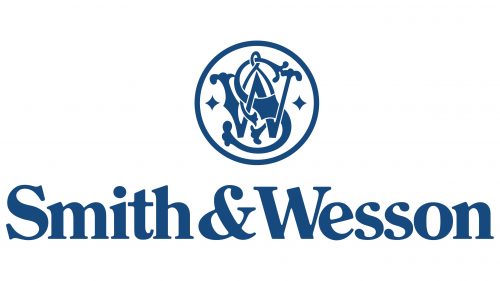The Smith and Wesson logo perfectly reflects the refined style of the revolvers produced under this brand from the beginning. The emblem exudes sophistication, elegance, and extravagance, characteristic of the clients who prefer this type of firearm.
Smith & Wesson: Brand overview
When Horace Smith and Daniel B. Wesson initially teamed up to form the “Smith & Wesson Company” in Norwich, Connecticut, in 1852, the history of Smith & Wesson officially began. Their first collaborative endeavor was theating the “Volcanic,” a revolver that uses paused paper cartridges; however, the endeavor was not profitable, and the business was sold in 1855.
Despite this early disappointment, Smith and Wesson persisted in pursuing their goal. They established “Smith & Wesson,” a new business, in Springfield, Massachusetts, on November 8, 1856. This is the day the current company is officially said to have been founded.
The firm unveiled the Model 1, their first popular revolver, in 1857. It was the first revolver to use metallic cartridges and be commercially successful worldwide. Because of its dependability and simplicity, the Model 1 became well-known quickly.
The demand for firearms sharply spiked during the American Civil War (1861–1865). The corporation provided revolvers to the Union Army, which greatly aided the organization’s expansion and advancement.
The renowned Model 3 American revolver, the brand’s first large-caliber revolver, was unveiled in 1869. The American Army adopted this revolver and exported it to several nations worldwide.
There were several significant technological advancements in the 1880s. The .38 Double Action First Model was the firm’s first double-action revolver, introduced in 1887. This innovation greatly accelerated revolvers’ rate of fire.
The company kept coming up with new ideas in the early 20th century. The .38 Safety Hammerless, originally released in 1899, was the company’s first revolver without an external hammer. The business started manufacturing its first semi-automatic handgun in 1905.
The manufacturer saw tremendous expansion throughout World Wars I and II. The corporation provided the armed forces of the United States and their allies with a substantial amount of weaponry.
In the history of guns, the company released several models in the 1950s that have now become classics. One was the Model 29 .44 Magnum, made well-known by Clint Eastwood’s film Dirty Harry.
There was a noticeable increase in manufacturing in the 1960s and 1970s. The firm started producing handcuffs, police gear, and other accessories.
In the 1980s, the company had to contend with growing competition from overseas producers. To respond, it created new pistol models, such as the Semi-Automatic pistol line.
The corporation underwent considerable transformation throughout the 1990s. Following the British corporation Tomkins plc’s 1987 acquisition, numerous changes in management and strategy occurred.
The company and the Clinton administration inked a contract in 2000 to include safety features in their products. Supporters of gun rights reacted negatively to this move, which resulted in a brief boycott of the company’s goods.
Tomkins plc gave up American ownership in 2001 when it sold the business to a consortium of investors. A new chapter in the firm’s history began with this occasion.
Meaning and History
What is Smith & Wesson?
It is a renowned American firearms manufacturer known for its range of quality firearms, including pistols, rifles, and shotguns. Founded in the mid-19th century, the company has a long history in the firearms industry. It is known for its revolvers, semi-automatic pistols, and modern sporting rifles used by military, law enforcement, and civilians worldwide. The company is known for its performance and safety, making it one of the most trusted names in the firearms industry.
1878 – 1900s
Since the American company targets wealthy and titled firearm enthusiasts, it chose a luxurious vignette-style logo. This vintage design resembles a monogram, characteristic of the late 19th century. The logo serves several functions:
- Prominently representing the brand in a competitive market.
- Subtly yet persistently advertising the product.
- Visually attracting attention to the company.
- Intriguing customers with the product range.
- Being a memorable face of the enterprise.
- Conveniently marking all types of branded goods.
As the Smith & Wesson trademark targets the nobility, officials, and high society, it preferred an emblem where a standard monogram represents an unconventional field. Therefore, it exudes sophistication, confidence, elegance, and security despite belonging to a highly risky industry.
The logo resembles a vignette, with three letters intricately intertwined, each depicted in an individual style. This helps the glyphs stand out, clearly distinguishing each symbol in the abbreviation.
- “S” is taken from the surname of the company’s founder, Smith. This is the largest and tallest letter in the logo. It connects the other two, acting as a unifying element. Despite its hook-like shape, the glyph is incredibly elegant, with split ends adorned with the popular heraldic element fleur-de-lis.
- “W” represents the surname of the brand’s second founder, Wesson. This letter is stretched in width and also features a fleur-de-lis design. The characteristic floral elements are located at the ends of the strokes. The entire glyph is lined with thick horizontal stripes.
- “&” entered the emblem as a connecting typographic symbol. It unites the two founders, showing them as equally important figures in the company’s operations. However, the depiction of the ampersand is somewhat sarcastic, as it looks like a piece of rope hanging from the upper curve of the “S.” It has knots at the ends, symbolizing determination and strength, and is colored black to stand out from the neighboring glyphs.
Both letters are designed in an Old English style—ornate and sophisticated, with spiked extensions in the middle of the strokes. Along with the connecting symbol, they form a balanced and harmonious whole reminiscent of embroidered initials on fine batiste carried by elegant ladies from high society. When they waved a handkerchief with such embroidery, it marked the beginning of a duel for their hearts, fought, as it should be, with Smith & Wesson revolvers.
1900s – 1972
The vignette-style emblem remained and took precedence over other elements. The changes made to it were minor and did not affect its shape or content. Designers only adjusted the ampersand to make it more familiar with contours. They also colored all the letters white and placed them in a black circle. The sharp contrast created a serious and businesslike atmosphere, even slightly alarming to caution about the dangerous nature of the product.
The monogram is surrounded by a wide light ring, which slightly eases the tense atmosphere, instills confidence, and balances the interweaving of Old English-style glyphs. The emblem shows that Smith & Wesson respects its roots, so its design innovations are limited to supplementing the existing emblem rather than radically replacing it.
Next to the signature symbol, which serves as a marketing tool, is the full name of the firearms manufacturer. The first line contains the founders’ surnames, written in an elegant font and uppercase. The refined letters maintain the nobility and elegance of the late 19th-century retro era.
All glyphs are semi-bold, alternating thin and thick lines, adding dynamism to the logo and expressing the two-dimensional object. Although the serifs may seem absent at first glance, they are present as miniature extensions at the ends of the strokes. The double “S” letters are particularly interesting, depicted like a trigger or a light puff of gunpowder smoke rising over the weapon after a shot.
The second line, with the word “Revolvers,” is in the same font as the top line. The letters are uppercase, serif, and semi-bold. They are also tall, as they are vertically stretched. The most interesting letter is the “O,” designed as a revolver barrel opening and underlined with a short stroke. The top and bottom inscriptions are aligned oddly—to the ampersand. However, this does not make the emblem off-putting; on the contrary, the imperfect alignment intrigues and attracts attention.
1972 – today
The Smith & Wesson logo remains relevant, having been updated with a modern design. The key feature is a round seal-like emblem with a monogram inside. This abbreviation of the firearm company’s name is transformed into a classic monogram to attract the target consumer segment and elevate the prestige of its branded revolvers. In this case, the circle and all its contents have been inverted: dark elements have become light, and light elements have become dark.
The capital “S” and “W,” intertwined, are flanked by two four-pointed stars. A long ampersand weaves through both letters, turning the ordinary emblem into a beautiful heraldic symbol. This significantly softens the aura of strictness, creating an atmosphere of artistic sophistication.
The word “Revolvers” has been removed from the text because, after many years of the brand’s existence, the world knows its range, making an introduction unnecessary. However, the remaining line has undergone a significant transformation. The inscription is in bold font with small serifs. The letters are now lowercase and have become massive, rounded elements, giving the impression of a flowing form due to the many curves in the glyphs.
The color scheme has also changed: the black-and-white palette has been replaced with a combination of blue and white. Blue symbolizes confidence, development, and reliability, evoking a sense of security, which is crucial for a firearm manufacturer. White represents beginnings, calmness, trust, and purity. This combination calms relieves tension and fosters a positive attitude towards the brand.








